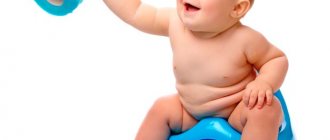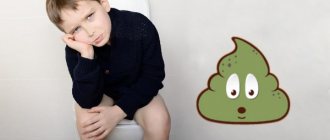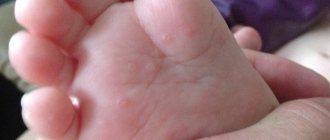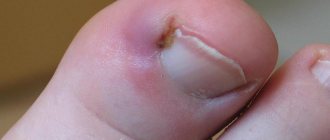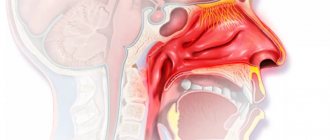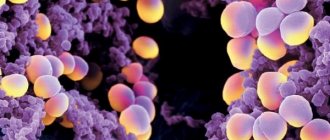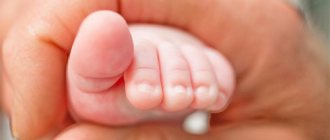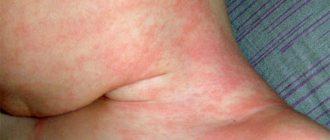Constipation (synonyms: obstipation, constipation) – a decrease in the frequency of bowel movements (less than 3 times a week) and a change in the consistency of stool. Chronic constipation can lead to mechanical and then paralytic intestinal obstruction. In this article we will look at what to do if a child has hard stools and how to soften the feces.
Constipation
Attention! In the International Classification of Diseases, 10th revision, constipation is designated by code K59.0.
Causes of hard stool
Mothers are wondering why their little babies are constipated? Constipation is a functional intestinal disorder in which stool is not completely eliminated from the body. Constipation is not an independent disease, but a common symptom that has many causes.
There are no clear standards defining the exact number of bowel movements or stool consistency in children. It is enough for children to defecate no more than three times a day and at least 3 times a week. Typical signs of constipation: a decrease in the frequency of stools less than three times every 7 days or a change in the consistency of feces.
Hard fecal matter due to constipation
In breastfed newborns, the frequency of bowel movements usually varies from 3-5 per day to once per week, but even longer intervals are possible (up to a maximum of 14 days). If there are no other complaints, this should not be a cause for concern.
Infants usually have difficulty defecating: they stretch their legs, moan and blush, but do not cry. First of all, this behavior simply indicates that lying down makes defecation difficult. If there is no strong odor and the stool consistency is normal, this behavior is not considered pathological.
Infants and schoolchildren often experience constipation. Problems with bowel movements often occur when the passage of stool is perceived as unpleasant or painful and the child resists the urge to go to the toilet. However, hard stool without discomfort is not considered constipation. A child who regularly passes small amounts of stool may be constipated if the amount of stool passed is less than what is produced in the intestines. There is no reason to worry if constipation lasts no more than three days, there is no pain and there are no streaks of blood in the stool.
Constipation has many causes and therefore requires medical evaluation. Often the cause lies in poor diet and lack of water (dehydration). Sometimes changing the diet (introducing complementary foods) temporarily causes constipation in infants.
Constipation sometimes results from painful bowel movements, causing the child to be afraid of going to the toilet and holding back stool. As a result, the stool is pushed back into the pelvis, where it no longer causes any irritation and thickens into a tight mass, which then causes even more pain and increases anxiety.
Hirschsprung's disease (lack of ganglion cells) is a rare cause of constipation. Congenital defects are generally an extremely rare cause of constipation. Various malformations (straight anus, narrowing of the intestines after surgery or Crohn's disease) can also lead to constipation.
Agangliosis
Other diseases and conditions that cause constipation: chronic lack of fluid, prolonged bed rest, hyperthyroidism, hypothyroidism, spinal cord lesions or autonomic neuropathies (as a result of diabetes).
Some medications cause constipation as a side effect. Most often these are narcotics, antidepressants, anticonvulsants, anticholinergics and antacids.
Painful or unpleasant experiences associated with defecation, especially in children between the ages of one and four years—when sphincter control is developing—play a role in the development of constipation. Children avoid further bowel movements and retain stool in the rectum. This subsequently makes defecation even more unbearable for the child.
Sheep feces in a child: possible causes and solutions to the problem
Constipation, as is known, is characterized by difficulty in defecation.
And if your baby's bowel movements are hard and irregular, they may look like sheep feces or pebbles. This problem occurs due to various physiological or nervous disorders. Irregular hard stool in a child is thick, hard stool, shaped like small balls, and it looks like pebbles. Often, sheep feces cause great discomfort to the baby in the form of painful bowel movements, abdominal pain, and flatulence.
The process of defecation may be accompanied not only by severe pain, but also by general weakness and fever.
Causes of hard (sheep) feces in a child
There are many reasons why a child may have hard stool. And here are the most common ones:
- dysbacteriosis;
- use of medications containing enzymes;
- stress;
- various diseases.
There are many reasons for the appearance of sheep feces in a child, but most often this problem is associated with dysbacteriosis . Dysbacteriosis can occur if the expectant mother suffered some kind of infectious disease during pregnancy, as a result of a cesarean section, or malnutrition of the baby.
medications with digestive enzymes to improve the digestion process. But regular use of drugs such as Panzinorm Forte, Mezim Forte, Creon, Festal, Smecta, Imodium and others very often becomes the cause of sheep feces.
Stress can also cause the appearance of hard feces in a child, and even in an infant. An unfavorable family environment, severe fear, potty training, conflicts in kindergarten or school, severe punishment of parents for wrongdoing - all this causes stress in the baby, and therefore the consequences in the form of constipation may not take long to come!
Various diseases , for example: anal fissure, abnormalities of the colon, pelvic floor pathologies, irritable bowel syndrome, diabetes, etc.
What to do if your child has hard stools?
What to do if your baby's poop looks like sheep's? There are many ways to improve your baby’s condition, but, of course, it is best to approach this issue comprehensively, not limiting yourself to one of the recommendations given.
- Give your baby more fluids to drink;
- increase the amount of fruits and dried fruits in the diet;
- minimize the consumption of flour products;
- give your little one homemade unsweetened kefir;
- Give your baby a belly massage and increase his physical activity.
If you notice that your child's stool looks like sheep feces, then the first thing you should do is increase the daily amount of liquid he drinks. You can give the patient water not only with clean water, but also with juices, compote, and fruit juice.
The diet should also be adjusted. If you have difficulty defecating, it is recommended to eat beets, pumpkin, apples, and kiwi. But it is advisable to eat dried fruits before bed. It can be raisins, prunes, dried apricots, figs.
During constipation, you should not eat flour products. When dealing with sheep feces, you need to minimize the consumption of bread and baked goods, noodles, dumplings, and rice. Even semolina porridge, which is familiar to babies, hardens the stool and can cause constipation!
Many people know that with hard stool you need to drink kefir. But sweet kefir, just like yesterday’s, strengthens the stool. Therefore, a patient with sheep feces should be given exclusively fresh homemade kefir and without sugar!
For sheep excrement, it is recommended to massage several times a day. Before eating, massage your baby's belly clockwise with smooth movements - this will improve the functioning of the gastrointestinal tract and help cure constipation.
If all these recommendations do not give a positive result and the child’s stool has not returned to normal and is still hard, he can be given lactulose syrup. This can be Duphalac, Normaze, Lactusan, etc.
Just remember that it is prohibited to use such drugs often! You can use them once to alleviate the condition and induce bowel movements.
If, despite all your actions, constipation does not go away within a few days, you should consult a doctor!
It is important to remember that hard sheep feces in a child is a very serious condition in which cracks can appear not only in the anus, but also on the walls of the intestines; it can also cause hemorrhoids and provoke rectal prolapse!
Source: https://razvitie-malysha.ru/ovechij-kal-u-rebenka-vozmozhnye-prichiny-i-sposoby-ustraneniya-problemy/
Symptoms
Symptoms are varied: repeated and short-term abdominalgia, bloating, involuntary defecation, inflammation of the peritoneum, sphincter rupture, inflammation in the rectum, pain during defecation, traces of blood in the stool, decreased frequency of stool, reluctance to empty the bowel.
Abdominalgia
Important! Many children develop mental problems due to pain caused by severe constipation.
Types of constipation
In medicine, there are two types of constipation in children:
- Atonic. It is characterized by bloating of the baby's abdomen due to the large volume of feces in the intestines. There is no urge to go to the toilet. Defecation occurs once every 2-3 days, which requires significant effort. Pain in the lower abdomen and a feeling of fullness may appear. The first stool has a very dense structure, sometimes with blood streaks.
- Spastic. In this condition, frequent intestinal spasms are observed, causing spasmodic pain. Feces come out in dense fragments. There is increased gas formation and, in some cases, belching. The overall tone of the body decreases.
By their nature, the following types of constipation are distinguished:
- Congenital - due to the anatomical features of the rectum, developmental defects and congenital diseases;
- Functional – for disorders of the gastrointestinal tract;
- Acquired - due to the development of neoplasms.
Diagnostics
First you need to exclude organic causes of constipation. For this, an accurate medical history (collecting an anamnesis) and an examination by a pediatrician is sufficient. Usually, no additional examinations are recommended. If symptoms do not improve with sequential therapy after six months, the diagnosis should be reconsidered.
If an organic cause is suspected, X-ray examination (with or without contrast agent) is recommended. If neuropathy is suspected, a sample of rectal tissue is taken (rectal biopsy) and examined for pathology (neurohistology). If hormonal imbalance or electrolyte deficiency is suspected, a blood sample (serum electrolyte levels, thyroid parameters, vitamin D concentration) is required.
Acetylcholinesterase
In rare cases, measuring rectal pressure (anorectal manometry) and ultrasound examination of the abdomen are required. Examinations are required in case of constipation if concomitant renal malformations are suspected. The examinations provide information about the width of the intestine.
If constipation is associated with retention of stool in a child, it is recommended to consult a child psychologist.
Diagnosis of constipation
In order to accurately identify the cause of constipation, a comprehensive diagnosis of the problem is carried out. First of all, the doctor collects an anamnesis, which includes:
- finding out the time of onset of constipation and the age of the child at this moment;
- determination of the clinical picture;
- daily diet;
- psychological aspects in a child’s life;
- degree of physical activity;
- painful bowel movements;
- carried out preventive measures.
After collecting anamnesis, the doctor conducts an external examination of the child. During palpation, he determines the functional state of the muscle group in the sphincter area, the presence of fecal stones, fissures or neoplasms. At this stage, laxatives, pro- and prebiotics may be prescribed for constipation.
If necessary, additional studies will be prescribed, the general complex of which includes the following:
- Ultrasound of the abdominal cavity and pelvic organs;
- stool analysis for dysbacteriosis;
- fecal analysis for helminths;
- coprogram - examination of feces to determine the functioning of digestion;
- Colodynamic study - determination of the functional state of the rectum;
- sphincterometry - study of the function of the internal and external sphincter;
- Anorectal manometry - determination of the tone of the anorectal muscles and their work during bowel movements.
- enterocolonoscintigraphy – study of intestinal motor function;
- endoscopy – to examine the condition of the intestinal mucosa;
- X-ray of the lumbosacral region - to identify pinched nerve endings.
This list of studies is provided for general information about methods for diagnosing constipation in children 8 months old. In most cases, laboratory tests of stool/blood and ultrasound are sufficient to correct stool. The examination is carried out with the participation of a pediatrician, gastroenterologist or pediatric proctologist.
First aid for a child
Although constipation is an extremely common problem among children, few studies have systematically examined different treatment regimens. Drug treatment is not required in all cases. For painful symptoms, it is necessary to prescribe symptomatic drugs (antispasmodics, prokinetics, analgesics).
A group of patients with severe constipation who do not respond to conservative medical therapy may require more aggressive treatments, including surgery.
Treatment methods for systematic constipation
Many people ask what to do if a child is constipated? Several randomized trials have shown that laxatives are useful in the treatment of chronic childhood constipation. Polyethylene glycol, mineral oil, magnesium hydroxide and lactulose are effective. These drugs can be used for a long time without significant risks.
Lactulose
The key to pharmacotherapy is to use enough laxative to achieve the desired effect. Children are usually prescribed short-term use of laxatives. Long-term use of these agents in young children is not recommended. Long-term laxative therapy is used only for severe pain and difficulty bowel movements.
If constipation persists for a long time, the doctor may use an enema to empty the rectum and thus relieve pain. However, an enema should not be the first choice. Under no circumstances should you take enemas frequently, as this will only make the problem worse.
The most effective treatment method is to eliminate the root cause of constipation. In the foreground is a diet high in fiber and sufficient fluids, ensuring the child can have painless bowel movements.
If a child has difficulty forming stool, parents can use milk sugar. Milk sugar promotes the growth of Lactobacillus bifidus in the intestines, which relaxes the consistency of stool. Lactulose is completely harmless even with long-term therapy. For older children, milk syrup has a stimulating effect.
Other substances that soften stool (softeners), such as macrogol, are also effective in relieving constipation. This drug binds water in the intestines, loosening the stool. It is important to carry out therapy for a long time and consistently until the child gets used to painless bowel movements. If mucus appears in the stool or the color changes to green, you need to consult a doctor.
An anesthetic ointment (xylocaine) is used as an aid before defecation.
In older children, diet is at the forefront: food should be versatile and rich in fiber. The child is advised to drink plenty of water and exercise. Laxatives are almost never required. Children who have a psychological problem should receive concomitant psychotherapeutic treatment. It is necessary to adhere to a diet rich in fiber even after complete reduction of symptoms.
Surgical therapy is used for serious diseases (Hirschsprung's disease, anorectal malformation or mechanical intestinal obstruction). If mental causes come to the fore, consultation on child psychology is required.
Sheep feces in a child: methods of treatment and disposal at home
Sheep feces in a child are dry lumps 1-2 cm in size, separated from each other. Normally, stool should not look like this. Disorders occur when one area of the intestine has increased tone, which interferes with the normal passage of masses.
Sheep feces in a child: what does it mean, why does it appear?
There may be several reasons for the appearance of stool in the form of balls in a child. The most common of them is dysbiosis. It can occur if a pregnant woman has been exposed to infectious diseases. Other reasons:
- C-section;
- improper maternal nutrition and feeding (quick transition to formula, early complementary feeding);
- use of medications with digestive enzymes (“Smecta”, “Imodium”, “Bifidumbacterin”, etc.);
- weak immunity;
- intestinal infection;
- helminthic infestations;
- bad ecology;
- stress.
Dysbacteriosis is also caused by taking antibiotics, in which case constipation may give way to diarrhea. To avoid this condition, after antibiotic therapy, a course of microflora restoration should be prescribed.
In older children, hard stools occur due to a sedentary lifestyle, eating dry food, and consuming small amounts of fiber and liquid. A child may defecate in peas if he has diabetes, anal fissures, an improperly developed colon, pelvic floor pathologies, irritable bowel syndrome, etc.
The child has hard stool. How can I help you?
Hard stool is a sign of incomplete bowel movement. Normally, the frequency of bowel movements should be at least once every two days. If this does not happen, the stool in the rectum begins to harden.
As a result, stool becomes irregular, it becomes painful for the baby to poop, pain in the abdomen, general weakness, and nausea may occur.
If a child has hard stools, parents will learn how to soften them from the following recommendations:
- To soften the stool, the child must be given a lot of liquid, mainly clean, drinking water.
- Fiber should predominate in the diet; you need to increase the consumption of vegetable dishes, fruits, and dried fruits.
- Until the child’s condition returns to normal, it is not recommended to give him flour products.
- It is beneficial for a baby to drink unsweetened, homemade kefir.
- You can treat constipation at home by massaging the abdomen, movements should be circular, clockwise.
Parents can also alleviate the condition with the help of syrups: Lactulose, Duphalac, Normaze, Lactusana, etc. The use of drugs is often prohibited. If the use of methods does not help, constipation does not disappear within several days, you should consult a doctor.
Diagnostics of sheep feces
You can tell about the appearance of sheep feces by external signs. The baby's feces are similar in appearance to sheep. There may be lumps of mucus and a strong odor. To determine the cause of the condition, the patient is prescribed:
- blood, urine, stool tests for laboratory research;
- bacterial culture for microflora;
- scraping the anal area;
- Ultrasound of the abdominal cavity;
- colonoscopy;
- sigmoidoscopy;
- X-ray of the intestines;
- fibrogastroscopy.
You can get a referral for examinations from a therapist or gastroenterologist.
Treatment by a gastroenterologist
If symptoms of spasmodic constipation recur regularly in a child, treatment is carried out by a gastroenterologist. The doctor conducts intestinal examinations to confirm or refute pathologies that could cause the appearance of dense stool. When diseases are detected, therapy is aimed at treating them and eliminating constipation.
To soften hard stools, a specialist will recommend drinking 2 liters of clean water a day and eliminating foods that irritate the intestines from your diet.
Treat spasmodic constipation:
- "Duspatalin" (increases peristalsis);
- "Lactusan" (has a laxative effect);
- "Linex" and "Bifiform" (restore intestinal microflora).
In some cases, surgery may be required; it helps solve the problem of intestinal deformities, tumors, and fecal impactions.
Constipation must be treated. Ignoring symptoms leads to accumulation and rotting of stool. Intoxication of the body occurs, the following appears:
- irritability;
- headache;
- bad feeling.
Neglected conditions lead to anal fissures, intestinal prolapse, hemorrhoids, and colon cancer.
Traditional methods of stool regulation
For severe constipation, enemas can be done to soften stool, but not too often. They use warm water, an infusion of herbs, and add oils to them.
It is not recommended to use soap solution. It can cause severe irritation and dry out the skin.
Oils
The use of pharmaceutical, petroleum jelly oil is effective. It is added to water enemas, used in the form of capsules or chewing gum.
The maximum daily intake for children is 15 capsules or 2-3 tablespoons of the drug in liquid form. Duration of treatment: 7 days. Then take a short break and repeat the treatment.
Almond oil has the same effect; take 2 tablespoons no more than 4 times a day.
Honey and fruits
Honey helps get rid of sheep feces. It is advisable to use it warm. The product is consumed 1 spoon on an empty stomach, washed down with a glass of water. You can enhance the effectiveness of the ingredient by adding prunes or melon. Plums, apricots, kiwis, figs and citrus fruits also help soften stool.
Wheat bran
To normalize the condition of the intestines, it is recommended to consume wheat bran brewed in water in the amount of 2 small spoons. The mixture is consumed 2 hours before breakfast, washed down with 2 glasses of water.
Burdock infusion
To prepare the medicine, pour boiling water over fresh leaves of the plant and leave for 3 hours. Strain the finished liquid, take 1 spoon before bed.
Dietary recommendations
To eliminate constipation in a child, it is important to monitor his diet. Meals are divided into 5-6 times, portions should be small.
It is advisable to eat at the same hours, then the food will begin to be absorbed more efficiently in the stomach. You should not drink food with water, it dilutes the gastric juice and interferes with normal absorption and proper bowel movements.
The diet of the baby or mother, if the child is an infant, should include:
- cereals;
- bran;
- wholemeal bread;
- green and herbal teas;
- dairy products;
- fish;
- vegetables;
- fruits.
If the stool is hard and consists of small lumps, the child should limit his consumption of sweets, flour and confectionery products made from white flour, rice and other foods high in protein. It is recommended to use traditional medicine recipes, as well as medications, only after medical consultation. You need to start with small doses to make sure there are no allergic reactions.
Source: https://kidabout.ru/malenkie-deti/ovechij-kal-u-rebenka-metody-lecheniya-i-izbavleniya-v-domashnih-usloviyah/
Medications
Osmotic laxatives produce an osmotic effect in the colon, which leads to increased peristalsis.
Polyethylene glycol
Polyethylene glycol (PEG) is a long chain of ethylene glycol molecules. This agent is very poorly absorbed and functions as an osmotic laxative. Tasteless and odorless powders completely dissolve in almost all liquids, including water.
PEG
The drugs are often used as cleansers in preparation for colonoscopy. In very large doses, PEG can cause nausea, flatulence, abdominal cramps and vomiting.
Magnesium hydroxide
Magnesium is a divalent cation that is maximally absorbed in the distal small intestine. At low concentrations, magnesium appears to be absorbed in a saturable, vitamin D-mediated manner.
At higher concentrations, magnesium absorption occurs primarily by diffusion. Elevated serum magnesium levels release cholecystokinin, which stimulates GI motility and secretion, which explains why some children experience abdominal cramps.
Lactulose
Lactulose is a synthetic, non-absorbable disaccharide available as a 70% solution. This agent is well tolerated and has a sweet taste. The preparations contain 10 g of lactulose per 15 ml of oral solution. Bloating, abdominalgia and flatulence are common side effects of the medication.
Sorbitol
Sorbitol is a sugar alcohol that is largely unabsorbed. It is available as an 80% solution. Like lactulose, sorbitol is generally well tolerated and has a pleasant taste. The drug can also cause flatulence.
Diet
A common cause of constipation is an unhealthy diet, especially a lack of fiber. Fiber is a plant ingredient that is not digested and ends up in the colon. Dietary fiber binds water, loosens stools and stimulates intestinal motility. Fiber-rich foods also contain vitamins, sugars and fats. Flax bread, contrary to popular belief, is ineffective because the grains are overheated during the manufacturing process. Ground flaxseed also does not have a significant effect, since the seed swells only while the fiber capsule is intact.
The child needs to be given small portions to eat, rather than large meals, and drink a lot of low-calorie liquid. Increased physical activity stimulates intestinal motility.
Foods that help soften stool:
- Brown rice, tomatoes,
- 1-2 liters of fluid per day depending on the child’s body weight,
- Fruits, especially plums, pears, apples, melons, apricots, dried fruits,
- Vegetable salads, mixed cereals, nuts.
Products harmful to children:
- White bread, bread crumbs, white rice, pasta, biscuits, bananas, puddings, cream, cakes, chocolate,
- Milk and dairy products,
- Chocolate and sweets.
Chocolate
There is no need to completely limit sweets. Muesli and sweet fruits are a good substitute for sweet foods. It is worth noting that enemas and laxative tablets should only be used after consultation with a doctor.
My child has hard stools, what should I do?
July 25, 01:20
Problems with stool
We are faced with such a problem as constipation, the child is 2.5 years old, he eats normally, before he had stool once every 2 days, and when they started potty training, she stopped going altogether, she categorically refuses to go to the potty, she only pees and poops while standing in diapers, started giving her Microlax enemas and helping her with glycerin suppositories, because... she cried a lot, the stool was very hard and, apparently, it was hard for her. Now I’ve been giving her the laxative Duphalac for 5 days, but it’s not strong for us... Read more →
Constipation
The child has, well, not exactly constipation, but stools in the form of hard peas. Previously, we saved ourselves with dried fruits and compote made from them, but an allergy to them began (a year later) and now I just don’t know what to do. We eat vegetables. What else can you serve besides duffalak? Continue reading →
problems with stool: (
Hello girls! We have such a problem, the stool is very hard, he walks every other day and with difficulty: (he drinks normally, also eats the “Nestazhen” mixture) Today I had to “help” pull out the poop, I couldn’t do it myself: (I don’t know what to do anymore...
The older one at the same age had the same problem and now he walks with difficulty, but every day. The doctors say let’s drink more, but I can’t force water into the child…. The eldest drinks a lot, it’s no use, the stool...
Continue reading →
How we got rid of constipation
Since birth, my daughter has had problems with bowel movements. Well, what are the problems... More likely, a tendency to constipation. Not regular bowel movements, but not critical, did not bother my stomach much, I walked on my own.
A glycerin suppository was used 2 times during the entire period, a cotton swab was used more often, but also not every day. I actively ate prunes and beets, supplemented them with fermented milk formula, and at the very least we pooped. And now it's time for complementary feeding. We started at 4.5 months with vegetables.
The first portions went with a bang, although we ate no more than 40g, then we didn’t... Read more →
When nothing helps
Maybe someone had a similar situation? Since birth, the child has had problems going to the toilet. At first it was just a rare stool. We tried Duphalac, massage, bacteria and generally everything that is usually recommended. The doctors promised that with the start of complementary feeding the problem would go away.
But it was not there !!! We started complementary feeding, it seemed to be getting better, then constipation again, only now it’s, sorry, rare and hard stool. I was teething and pooped hard poop 1-2 times every day, sometimes with diarrhea. My teeth came out and I stopped pooping. Well, not prunes...
Continue reading →
Search for a gastroenterologist, the problem is chronic constipation in a child, Moscow, Northern Administrative Okrug
Consult a gastroenterologist in the Northern Administrative District. There seemed to be some good reviews about the Gabrichevsky Research Institute? So far I'm aiming there. The problem is constant difficult bowel movements in a 4-year-old child. From birth.
There are no long gaps, but poop is difficult and sometimes bleeds (there are probably cracks already), the poop is like goat poop and hard. It’s sooooo rare that it has a good consistency. We drank Duphalac, and we try to adjust the nutrition (as far as possible with a child).
Bread is taboo in the house, pasta and rice have been removed altogether. I no longer know what to feed him and self-medicate... Read more →
Blood in the stool
Girls, the child is 2 years old, has had rare stools since birth, so far it’s not a problem, but complementary feeding has started, it’s worse here. Once every two days is its maximum frequency. Despite the fact that I give fiber and water right to the eyeballs. The stool during these two days is formed and plentiful, like that of an adult.
From time to time there are spots of blood, at the beginning, so to speak, of the process where the feces are hard. Well, everything seems logical, volume and density are mechanical damage. But recently I had soft stools and just a couple or three drops of blood...
Continue reading →
Mucus in the stool with bloody scarlet specks and a foul odor.
Girls, hello! I will be immensely grateful for your experience! The doctor suggests an allergy to cow protein, since stool tests did not find viruses or bacteria. The story goes like this.
The child is one year and two months old. At the beginning of February, she began to introduce eggs, quail, fresh, and after 2-3 days the child began to feel unwell, with a rising temperature and obvious pain in the abdomen, because sleep even at night became very restless.
The next morning, diarrhea mixed with mucus and a small amount of scarlet blood, later stools became frequent, and sometimes even just... Read more →
dysbacteriosis?
girls, I don’t have the strength.... I’m confused looking for symptoms, making diagnoses and wondering!!!!! This week my child got a dusting on his cheek (I wrote about this at length and in detail in other posts).
categories) in general, our pediatrician said that it was an allergy (I needed a diet, and the child needed fenistil), the entire baby blog kept telling me that it was just a hormonal rash...
In the end, I decided to dispel all doubts and signed up for a private clinic for a paid consultation with a dermatologist! In order not to write 100,500 unnecessary words, I’ll get straight to the point: the dermatologist shrugged her shoulders and sent… Read more →
The child does not drink... severe constipation (((
My daughter is almost ten months old, two days ago the composition of the diet was as follows: 4 times breast, 200 g biolact tema, 50 g tema curd, 80 g vegetable puree with olive oil, 140 g milk porridge (Frutonyanya oatmeal with milk), 50 g fruit puree . From drinking – 30 g of water….. Read more →
Baby has hard stool at 3 weeks
Hello, the baby is 3 weeks old. We have been on IV since birth. At first we ate Nutrilon comfort, everything seemed to be fine. For about a week. Then the stool began to harden and became less frequent. But for several days now, the child’s stomach has been bubbling very loudly, especially during and after feeding.
The child twists his legs, tenses, as if pushing. The stool became hard balls, 1 or 2 small balls. Since yesterday she has been screaming a lot and has difficulty falling asleep, constantly waking up. The comfort mixture is considered to be for colic and constipation, but colic...
Continue reading →
The child has problems with bowel movements*(What should I do?
My child is 3.2 years old, he has never had problems with bowel movements, he goes several times a day.
But here we recently got sick with an acute respiratory viral infection (we took antibiotics), after which the child has not been able to poop for a week ((((sulking, sulking, crying... small, very dry and hard poop comes out..... I have to do an enema... And so everyone day...What to do???? Read more →
Problems with stool in a child.
Hello. We have had problems with bowel movements since birth. But now everything has become simply terrible. My son goes mostly once every 3-4 days. At the same time, the child “performs a ritual dance”, stamps his feet and pushes very hard... but it seems to me that by doing this he is pinching the poop.
The stool is quite hard, and recently it has become discolored. OAC is normal. They didn’t give me a referral for dysbacteriosis...they said since the general condition is normal, what should I look for? The food is varied, soups, cereals, vegetables and fruits. I give compotes from dried fruits, prunes, beets. We drank Duphalac. Nothing helped. It's like that…
Continue reading →
I didn’t write a report about the year)))
I'll start with the bad...
Teeth! Nastya was here for 3 days with a high temperature, which went down for a very short time and again, the gums are swollen, hard, but they won’t break through, the 3 upper ones are crawling at the same time! Because of this, we spent all these days sitting on our arms, only on our arms and nothing else, even for a minute! Even before this, guests came to us and Nastya, again, was afraid of something and again sat in her arms, so we have a child who sat in her arms... Read more →
Colic in infants
All of the following applies to children on full breastfeeding without formula feeding or other complementary foods up to 6 months. Infant stool is one of the problematic issues for many mothers.
In the mid-20th century, as formula feeding became more common than breastfeeding, a new stereotype of “normal” bowel movements emerged.
Formula-fed babies poop differently than infants: formula-fed stool is relatively infrequent, comes out formed and smells bad, reminiscent of adult stool. While stool from breast milk in the first 6... Read more →
baby hasn't pooped for 2 days
Save the girls and help with advice. My friend’s baby just turned one month old. They are mixed-fed because she does not have enough milk for the baby to eat.
It happens that the baby does not poop for 2 days, what should I do? He is in great pain, whimpers and cries, wriggles around as best he can, pushes constantly, and farts, but just can’t poop.
The last time her mother visited them, and after touching the child’s tummy she was horrified, as he was... Read more →
Repeated vomiting...
Maybe someone can help us find the answer to a disease unknown to us.
It all started with the fact that 2 days ago I was terribly vomiting and the toilet was my best friend for 24 hours, my husband had to take the weekend to help with the child, I didn’t have the strength to get out of bed.
Today is day 3 and after a nap my son starts vomiting. They immediately called an ambulance, they learned about my illness (I don’t know whether it was poisoning or a virus) and said that I had infected the child... Read more →
Help with advice! Problem with stool
Hello, girls! This is not a pleasant question, I hope that someone can tell me which direction to move in! Now my bagel is 2.1.
I had problems with stool from birth, I received a lot of high-dose antibiotics and at the same time in the maternity hospital I was forced to breastfeed (the stay was separate, but the child was not supplemented - the policy of the maternity hospital). With complementary feeding, from the age of 5.5 months, stool became more or less normal. At 6 months the baby fell ill.
They struggled with the diagnosis for a long time, they treated it incomprehensibly, and as a result, from 6.5 to 10.5 months the child was on a/b, almost continuously... Read more →
Hello BB. A little bit of my history...
Hi all. I’m new to BB... I’m still a newbie... so don’t judge too harshly))) I’ll tell you a little about myself for understanding:
Source: https://www.BabyBlog.ru/theme/u-rebenka-tverdyi-stul-chto-delat
